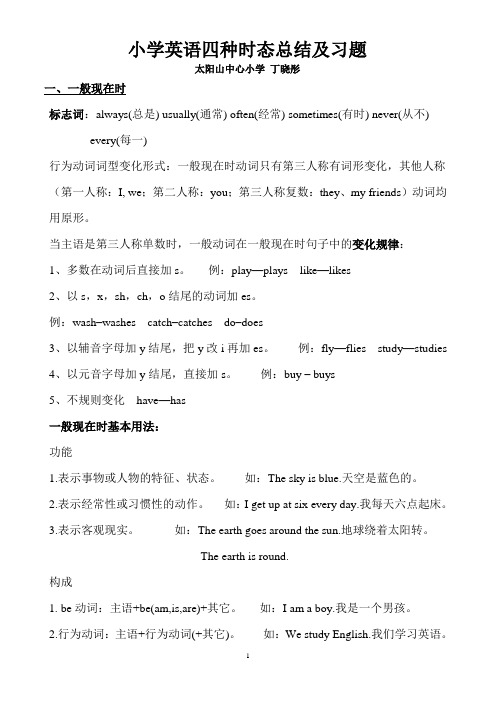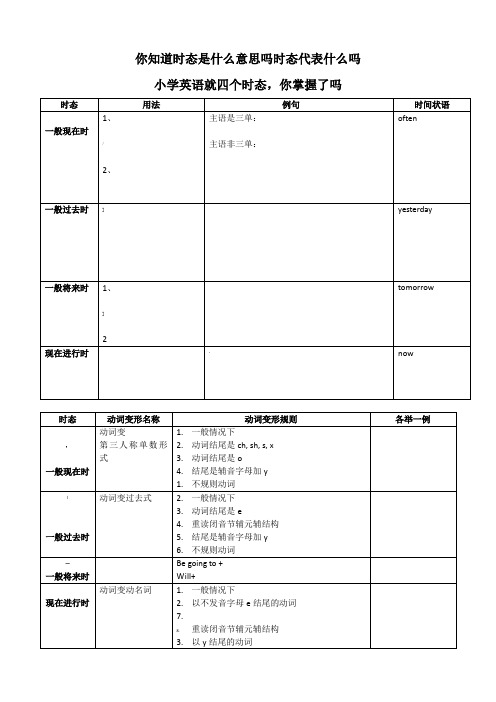小学英语四种时态的区分及练习
小升初英语四大时态复习讲解及真题专项练习含答案

小升初英语四大时态复习讲解及真题专项练习含答案一、重点讲解考点一:动词的基本形式1.动词原形(分实义动词、助动词、系动词、情态动词4类)(1)助动词(do/does/did)紧随其后的动词用原形;(2)情态动词(can/could/should/must/would/will/shall/maybe)紧随其后的动词用原形;(3)祈使句(表示命令式的语句)用原形;Eg: Open the door, please.(4)固定搭配。
let sb do sth/help sb do sth/make sb do sth/why not do sth.2.第三人称单数(用于一般现在时)变形规则:(1)一般在动词词尾加s。
如: work→works、read→reads、look →looks、live→lives。
(2)以ch、sh、s、x结尾的,在词尾加es。
如: catch→catches、finish→finishes、guess→guesses、。
(3)以o结尾的动词,分2种情况:有生命的加es,如:hero,tomato,potato;没有生命的加s,如:radio,photo。
(4)以辅音字母加y结尾的动词,变y为ies。
如: fly→flies、study →studies、carry→carries.(5) 不规则变化。
如: have→has ,are→is,were→was3.现在分词(用于现在进行时)变形规则:(1)一般在动词后加ing。
如: work→working、read→reading、look →looking、wait→waiting。
(2)以不发音的e结尾的动词,去掉e,再加ing。
如: smile→smiling、move→moving、take→taking、write→writing。
(3)以重读闭音节结尾的且词尾只有一个辅音字母的,双写这个辅音字母加ing。
如: sit→sitting、stop→stopping、cut→cutting、run →running、swim→swimming.(4)少数几个以ie结尾的动词,将ie改为y加ing。
(完整版)小学英语四种时态练习题丁晓彤

小学英语四种时态总结及习题太阳山中心小学丁晓彤一、一般现在时标志词:always(总是) usually(通常) often(经常) sometimes(有时) never(从不) every(每一)行为动词词型变化形式:一般现在时动词只有第三人称有词形变化,其他人称(第一人称:I, we;第二人称:you;第三人称复数:they、my friends)动词均用原形。
当主语是第三人称单数时,一般动词在一般现在时句子中的变化规律:1、多数在动词后直接加s。
例:play—plays like—likes2、以s,x,sh,ch,o结尾的动词加es。
例:wash–washes catch–catches do–does3、以辅音字母加y结尾,把y改i再加es。
例:fly—flies study—studies4、以元音字母加y结尾,直接加s。
例:buy – buys5、不规则变化have—has一般现在时基本用法:功能1.表示事物或人物的特征、状态。
如:The sky is blue.天空是蓝色的。
2.表示经常性或习惯性的动作。
如:I get up at six every day.我每天六点起床。
3.表示客观现实。
如:The earth goes around the sun.地球绕着太阳转。
The earth is round.构成1. be动词:主语+be(am,is,are)+其它。
如:I am a boy.我是一个男孩。
2.行为动词:主语+行为动词(+其它)。
如:We study English.我们学习英语。
句型肯定句:A. be动词:主语+ be + 其它成分如:He is a worker.B.行为动词:主语+动词(注意人称变化) +其它成分如:We like the little cat.否定句:A. be动词:主语+ be + not +其它成分如:They are not students.B.行为动词:主语+助动词(do/does) + not +动词原形+其它成分如:We don’t like the little cat.一般疑问句:A. be动词:Am / Is /Are +主语+ 其它成分如:Are you a teacher? Yes, I am. / No, I am not.Are they students of your school?Yes they are / No they aren’t.B.行为动词:助动词(Do/Does)+主语+动词原形+ 其它成分如:Do you like it? Yes, I do. / No. I don’t .Does he(she) like it? Yes, he( she )does. / No, he ( s he )doesn’t.特殊疑问句:疑问词+ 一般疑问句A. be动词:How many students are there in your school?B.行为动词:What do you usually do on Sunday?一般现在时动词be和have的变化形式1.动词Be 用法:第一人称单数用am,第三人称单数用is,其它人称用are。
小学英语四大时态总结及练习题

你知道时态是什么意思吗时态代表什么吗小学英语就四个时态,你掌握了吗你能发现它们之间的共同点和不同点吗勤加练习,百战不殆I.把下列动词变为第三人称单数形式。
1. clean--2. go--3. have--4.do-6. fly--7. come-- brush-9. watch-- 10. study-- 11. ask--(13. swim-- 14. catch-- 15. write--16. eat-- 17. make-- 18. paint—19. learn-- 20. phone-- 21. run—22. hop-- 23. sing-- 24. pick—II.把下列动词变成过去式is\am________ fly______ plant________are________ drink_________ play_______go________ make ______ does_________dance________ worry________ ask _____ taste_________ eat__________ draw________put ______ throw________kick_________ pass_______ do ________III.把下列动词变成动名词形式。
Wake________ make__________ come____________have____________!Take_________ leave__________ rid_________, regret__________, Begin________,cut________, get_________, hit_________, run_________, set_________, sit__________, spit__________, stop_________, swim________,beg_________, drop__________, fit_________, nod_________, dig___________, forget_________, travel_________visit_________Carry_________ enjoy___________ play ___________ study ________die_________ lie_________多加练习,百战不殆之时态篇一、用单词的正确形式填空:1.Mike _________ (do) his homework every day.2.There __________(be) some water in the glass.3.We like ________ (play) basketball after class.4.I like singing. I often _________(listen) to the music in the evening.5.【6.My grandma_________(watch) TV every day.二、判断句子的正误, 并改正。
小学英语常见四种时态

小学英语常见四种时态一、一般现在时:动词+S1.特殊情况:(1)sh 、ch、o结尾的+es例如:wash_(wash es) watch_(watch es) do_(do es)(2)(2)以y结尾的:把y变成i +es例如:study——(stud ies)2.用单词的正确形式填空:1)Mike does (do) his homework every day.2)My grandma watches (watch)TV every day.3)I often listen (listen)to the misic in the evening.二、现在进行时:动词+ing1.特殊情况:(1)以e结尾,去掉e,+ing例如:make(making) come(coming) dance(dancing)(2)双写结尾字母:sit(si tt ing)swim(swi mm ing) run(ru nn ing)2.用单词的正确形式填空:(1)look! li hua and Mike are singing(sing) now.(2)The small bear is climbing(climb)the tree.(3)My brother is making(make) kites.(4)Lily is sitting (sit) on the chair.三、一般过去时:动词+ed1.特殊情况:(1)有e结尾的,直接+ d例如:like(liked) live(lived)(2)有y结尾的,把y变成+ed 例如:cry(cried)study(studied)(3)不规则变化eat(ate) get(got) see(saw) spend(spent) do(did) teach(taught) win(won) write(wrote) buy (bought) swim(swam)go(went) meet(met) are(were) is(was) am(was)2.用单词的正确形式填空:(1).Did you water the flower yesterday.(2)L i Hua went(go) for a walk last Sunday.(3)M ike didn’t finish (finish)his homework yesterday.(4)I picked apples on the tree last month.四、一般将来时:(1)Shall/will +动词原形(shall只能用于第一人称I /we shall)(2)be going to +动词原形(表示打算做什么)be going to+地点(表示准备去)例如:1.I am going to see a film tomrrow.2There will be a party in our school3.Mike will visit his grandpa next week.。
小学英语四种时态__谢

4.There
are (be)four seasons in(be) a tall girl. is 6.I
go (go)shopping once a week.
现在进行时(Present Progressive)
概念: 表示现在正在发生的动作h 或存在的状态 结构: be (is, am, are) + doing
小学英语动词的时态练习
(
)6. Did your father his friend on the 5th of October? A. called B. call C. is calling )7. Where A. was you last night? B. are C. were
4. 特殊疑问句
特殊疑问词+一般疑问句+? What is your father? 你爸爸是干什么的? What do you do every day? 你每天做些什么? When does your mother go to work every day? 你妈妈每天什么时候去上班?
小学英语四种时态的区分及练习

精心整理一般现在时:表示经常习惯发生的事,经常与always(总是),usually(通常),often(经常),sometimes (有时),every(每个),at+点钟连用。
结构:主语是复数动词用原型,主语是第三人称单数动词用三单。
三单变化规则:1.直接在动词后+s,例clean—cleans2.以s,x,ch,sh,或o结尾的动词+es例watch--watches,dish—dishes,fix--fixes,do—does,go—goes3.以辅音字母+y结尾的动词变y为i再+es,例fly—fliesstudy—studies(以元音字母+y结尾,直接+s例play—plays)1.2.10.Doesshe(do)homework?现在进行时:表示正在发生或正在进行的事,句中经常有(now,look,listen,it’s+几点钟等提示词)结构:主语+be动词(am,isare)+动词ing(现在分词)现在分词变化规则:1.在动词后直接加ing,例:go-going。
2.以不发音字母e结尾,去e再+ing,例:take-taking,3.辅元辅结构,且末尾只有一个辅音字母的动词要双写尾字母再加ing,例:swim-swimming,run—running,get—getting,put-putting,sit-sitting,begin—beginningstop—stopping,shop—shopping,现在进行时句型转换:肯定句Sheiscleaningherroomnow疑问句Isshecleaningherroomnow?(一提,二变,三问号)否定句Sheisnotcleaningherroomnow(在be动词后+not)特殊疑问句的结构:疑问词+be+主语+动词ing?例:Whatareyoudoing.一、写出下列动词的现在分词:7例:Whatareyougoingto/willdotomorrow?用所给动词的适当形式填空1.Todayisasunnyday.We___________________(have)apicnicthisafternoon.2.Mybrother_______________(go)toShanghainextweek.3.Tomoften______________(go)toschoolonfoot.Buttodayisrainy.He______________(go)toschoolbybike.4.Whatwillyoudodonextweekend?I__________(watch)TVand____________(catch)insects?5.TomorrowisFriday。
小学四种时态试题及答案

小学四种时态试题及答案一、一般现在时1. 我每天上学。
A. go to schoolB. goes to schoolC. am going to schoolD. am going to go to school答案:A2. 他经常帮助别人。
A. He often help others.B. He often helps others.C. He often helped others.D. He often helping others.答案:B3. 我们喜欢游泳。
A. We like to swim.B. We likes to swim.C. We liked to swim.D. We liking to swim.答案:A二、一般过去时4. 昨天我去了图书馆。
A. I go to the library yesterday.B. I went to the library yesterday.C. I am going to the library yesterday.D. I go to the library yesterday.答案:B5. 他们上周看了电影。
A. They watch a movie last week.B. They watched a movie last week.C. They are watching a movie last week.D. They will watch a movie last week.答案:B6. 她昨天买了一本书。
A. She buy a book yesterday.B. She bought a book yesterday.C. She is buying a book yesterday.D. She will buy a book yesterday.答案:B三、一般将来时7. 明天我要去看医生。
A. I am going to see a doctor tomorrow.B. I go to see a doctor tomorrow.C. I went to see a doctor tomorrow.D. I will go to see a doctor tomorrow.答案:A8. 他们将要参加比赛。
(译林版)小学英语四种时态复习-附练习及答案

小学英语四种时态复习一提到时态,就必然用到动词。
首先要明确两个概念:动词有五种形式,即:原形(形式),第三人称单数(形式),过去式(形式),现在分词(形式),过去分词(形式)。
小学阶段,句子有以下四种常见时态,即:一般现在时态;一般过去时态;一般将来时态;现在进行时态。
式,意思就是各种不同的形式,是对应着动词来说的;时态,意思就是表达各种不同的时间的事情,是对应着句子来说的。
式与时,先搞懂区别。
一、一般现在时态一般现在时用法口诀一般现在时,every, usually, often, sometimes.第一、二人称和复数,动词原形不变换。
除了I, you,复数外,动词后加s(es)别忘怀。
要变一般疑问句,be动词提前很容易。
若是没有be动词,Do和Does开头要注意。
否定句,很简单,not 在be 动词后面站。
若是没有be动词,do, does加not 要牢记。
请把这些规律记,一般现在时没问题。
一般现在时态,可能是两种意思。
第一,表示经常性的动作,常与often, sometimes, usually, every day, everyweek, every month, every year等表示频率的副词连用。
例如:He often goes swimming in summer.I usually go to work by bike.Sam visits China every year.第二,表示现在的状态。
如:My mother is a worker.There is a computer in our classroom.注意问题:be (am, is, are) 动词就是独立的谓语动词,一个句子中有了be(am, is, are) 就有了谓语动词了。
句子中不能同时出现两个谓语动词。
不少同学经常出这样的错误:The boy is often eats hamburgers.(错)应改为:The boy often eats hamburgers.二、现在进行时态正在进行时态口诀现在分词用途多,进行时态不用说。
- 1、下载文档前请自行甄别文档内容的完整性,平台不提供额外的编辑、内容补充、找答案等附加服务。
- 2、"仅部分预览"的文档,不可在线预览部分如存在完整性等问题,可反馈申请退款(可完整预览的文档不适用该条件!)。
- 3、如文档侵犯您的权益,请联系客服反馈,我们会尽快为您处理(人工客服工作时间:9:00-18:30)。
精心整理
一般现在时:表示经常习惯发生的事,经常与always(总是),usually(通常),often(经常),sometimes (有时),every(每个),at+点钟连用。
结构:主语是复数动词用原型,主语是第三人称单数动词用三单。
三单变化规则:1.直接在动词后+s,例clean—cleans
2.以s,x,ch,sh,或o结尾的动词+es例watch--watches,dish—dishes,fix--fixes,do—does,go—goes
3.以辅音字母+y结尾的动词变y为i再+es,例fly—flies
study—studies(以元音字母+y结尾,直接+s例play—plays)
1.
2.
10.Doesshe(do)homework?
现在进行时:表示正在发生或正在进行的事,句中经常有(now,look,listen,
it’s+几点钟等提示词)
结构:主语+be动词(am,isare)+动词ing(现在分词)
现在分词变化规则:1.在动词后直接加ing,例:go-going。
2.以不发音字母e结尾,去e再+ing,例:take-taking,
3.辅元辅结构,且末尾只有一个辅音字母的动词要双写尾字母再加ing,
例:swim-swimming,run—running,get—getting,put-putting,sit-sitting,
begin—beginning
stop—stopping,shop—shopping,
现在进行时句型转换:肯定句Sheiscleaningherroomnow
疑问句Isshecleaningherroomnow?(一提,二变,三问号)
否定句Sheisnotcleaningherroomnow(在be动词后+not)
特殊疑问句的结构:疑问词+be+主语+动词ing?
例:Whatareyoudoing.
一、写出下列动词的现在分词:
7
例:Whatareyougoingto/willdotomorrow?
用所给动词的适当形式填空
1.Todayisasunnyday.We___________________(have)apicnicthisafternoon.
2.Mybrother_______________(go)toShanghainextweek.
3.Tomoften______________(go)toschoolonfoot.Buttodayisrainy.He______________(go)toschoolbybike.
4.Whatwillyoudodonextweekend?I__________(watch)TVand____________(catch)insects?
5.TomorrowisFriday。
What_____she_________(do)?She______________(watch)TVand(listen)tomusic.
6.you(visit)yourgrandmanextSaturday?
选择填空
1.They________anEnglisheveningnextSunday.
A.arehaving
B.aregoingtohave
C.willhaving
D.isgoingtohave
2.______yourbrother______amagazinefromthebookstore?
A.Are;goingtobuy
B.Is;goingtobuy
C.Will;buys
D.Are;goingtobuys
3.NextyearI14yearsold.
A.will,be
B.isgoingtobe
C.am
D.amgoingto
(元音
-ed例:
1.
定句2.
特殊疑问句结构:疑问词+did+主语+V例:Whatdidyoudolastnight?
用所给单词的适当形式填空
⒈He_____(visit)theGreatWalllastyear.
2.We________(have)agoodtimeyesterday.
3.Weoften_______(go)toschoolbybuslastyear.
4.I________(live)inthevillagewhenIwasachild.
5.Mike______(see)abigtigerinthenatureparklastyear.
6.Sam_____(do)thehouseworkyesterday.
7.______(do)you_______(go)cyclingyesterday?
8.______(do)you_________(play)badmintonyesterday? No,Ididn't.I_____(draw)somepicturesintheartroom.
9..I______(eat)alotsoffreshfoodinthedininghallyesterday.
10.There____(be)manysheeponthefarmlastyear.。
